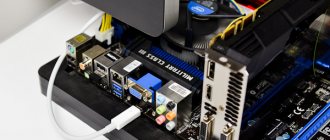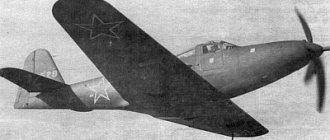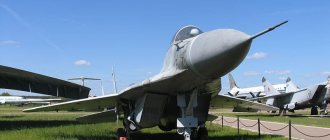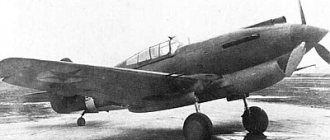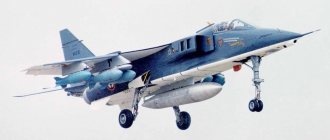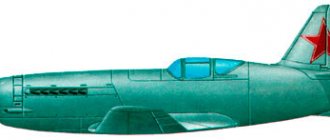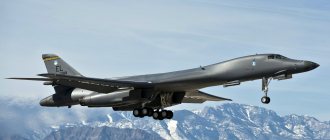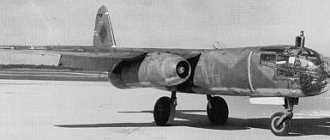Characteristics of the F-84
A country:USAType:FighterYear of issue:1946Crew:1 personEngine:1x J35-A-17D, thrust 2270 kgfMaximum speed:980 km/hPractical ceiling:13180 mRange of flight:2376 kmEmpty weight:4633 kgMaximum take-off weight:10197 kg (normal takeoff: 6685 kg)Wingspan:11.11 mLength:11.77 mHeight:3.91 mWing area:24.19 sq.m.Weapons:6x 12.7 mm machine guns, up to 1090 kg bomb load.
Specifications shown for the F-84E model
Notes
- [www.au.af.mil/au/afhra/avc.asp Air Force Historical Research Agency - Aerial Victory Credits] (inaccessible link since 08/23/2013 (3075 days) - history
,
copy
) - McLaren, David. Republic F-84 Thunderjet, Thunderstreak & Thunderflash: A Photo Chronicle. Atglen, Pennsylvania: Schiffer Military/Aviation History, 1998.
- [www.alternatewars.com/SAC/F-84E_Thunderjet_Block_25_and_30_SAC_-_18_July_1951.pdf Standard Aircraft Characteristics. F-84E-25&-30 Thunderjet]. — The Secretary of the Air Force, 18 July 1951.
The history of the creation of the F-84 Thunderjet fighter
The development of the P-84 jet fighter to replace the P-47 Thunderbolt piston fighter began at the Design Bureau (USA) back in 1944 under the leadership of A. Kartveli. Initially, it was planned to install a turbojet engine on the P-47 airframe, but later it was decided to develop a completely new aircraft.
The aerodynamic design of a low-wing aircraft with a straight wing and a laminar profile was chosen. It was decided to use the GE-100 (J35) engine with an axial compressor as the power plant. The air intake was placed in the forward part of the fuselage. A large air brake was installed under the fuselage, directly below the cockpit.
In March 1945, the company received an order from the US Army Air Forces for 3 prototypes and 400 production aircraft. As the war in the Pacific drew to a close, many orders were cancelled, but on January 15, 1946, the US Army Air Forces confirmed an order for 15 pre-production YP-84As and 85 production P-84Bs.
Drawing of the F-84 (P-84) Thunderjet fighter
Initially, the development team intended to make do with “little loss” by placing the turbojet engine in the lower part of the fuselage - according to the given design, but for such a design solution the turbojet engine with an axial compressor was too long. As a result, in October 1944, Kartveli began developing a completely new aircraft with an engine located inside the fuselage, behind the cockpit. With this arrangement, the entire useful volume of the fuselage was filled, and there was practically no space left for fuel tanks, so the main fuel supply had to be placed in the wing.
On November 11, 1944, the Air Force leadership officially approved the new project and ordered three prototypes of the aircraft. The first, designated XF-84, was built in December 1945. At the end of 1946, the company’s new brainchild was given the name “Thunderjet” “Thunder ” inherited from the P-47 - Thunder and the word “Jet” - jet). In February 1945, a presentation of the aircraft took place. Representatives of the Air Force appreciated the new machine, ordering 25 pre-production YP-84A and 75 production P-84A . A little later, the number of production aircraft was increased by 10 aircraft, correspondingly reducing the number of pre-production ones.
The first prototype of the new fighter was ready in December 1945 and made its first flight on February 28, 1946. Three prototypes, powered by a General Electric J35-GE-7 engine with a maximum thrust of 1,700 kgf, were followed by 15 aircraft designated YP-84A, with a more powerful Allison J35-A-13 engine and an armament of six 12.7 mm heavy machine guns. M2 with a rate of fire of 400 rounds per minute (on production vehicles they were replaced by MZ machine guns with a rate of fire of 1200 rounds per minute). Pylons were mounted on the wing to hang bomb and missile weapons. On September 7, 1946, a speed record was set for the United States - 977.6 km/h (the world speed record of 985.7 km/h belonged to the English aircraft Gloster “Meteor”).
In an effort to quickly begin mass production, the flight range was increased to 1,370 km by installing additional fuel tanks with a capacity of 870.5 liters at the ends of the wing. Flight tests of machines with such tanks were carried out formally, without carefully checking their effect on the stability and controllability of the aircraft. At speeds of up to 800 km/h and overloads of up to 4 g, the production F-84 behaved perfectly, and when these values were exceeded, the aircraft turned into an unguided projectile. It turned out that outboard fuel tanks shift the aerodynamic focus and twist the wing, increasing its angle of attack. At the same time, the forces on the aircraft control stick drop to almost zero, giving the pilot the impression of a complete loss of control. Eliminating this harmful phenomenon was extremely difficult due to changes in the mass of the tanks during the flight. The company's specialists had to increase the thickness of the wing skin, which increased its rigidity and, accordingly, reduced its twist, and also attached small triangular wings to the tanks, which shifted the aerodynamic focus. These improvements benefited the Thunderjet, and after testing, flights on the F-84 were approved.
Serial modifications
F-84B The first mass-produced model of the aircraft, it was equipped with a J35-A-15 engine, 6 12.7 mm machine guns and guides for missiles under the wings. 274 aircraft were built.
F-84C Designers returned to the J35-A-13C engine with a more reliable fuel system, and the fuel, hydraulic and electrical systems were improved. 181 aircraft built.
F-84D Variant with more powerful J35-A-17 engine and strengthened wing, 154 built
F-84E On this version, to install a more powerful J35-A-17D engine, the fuselage was lengthened, the wings were again strengthened and the cabin was enlarged. As a result, the characteristics declared during the development of the fighter were finally achieved, and the speed exceeded 965 km/h.
F-84F “Thunderstreak” The aircraft had swept wings, a modified tail and a Wright J65-W-3 engine, which increased speed, maneuverability and climb rate. 2,713 aircraft were built, 1,305 of which were in service with NATO countries.
F-84G A modification capable of carrying a nuclear bomb, equipped with an in-flight refueling system and an autopilot. Due to more capacious external fuel tanks, the flight range reached 3240 km. 3025 vehicles were built, of which 1936 were delivered to NATO countries.
The Thunderjet first entered combat during the Korean War, when the command of the American Army urgently needed to counter the Soviet MiG-15, which appeared at the front in 1950, with an aircraft capable of fighting it. It quickly became clear that the F84 was unable to compete with it for air superiority, but it was able to replace the F-80C “Shooting Star”, whose flight range, speed and payload capacity were inferior to the Thunderjet, as a fighter-bomber.
During the entire war, F84s of all modifications made 86,408 combat missions, in which 8 MiG-15s were destroyed (3 were confirmed from the opposing side) and 1 Yak. Soviet pilots declared the destruction of 186 F-84s (after double-checking, this figure was reduced to 178), Chinese pilots - 27. According to official American data (USAF Statistical Digest document FY1953), a total of 358 F-84s were lost in the war (of which 249 were lost in combat and 109 in incidents). At the same time, about 60% of ground targets were hit by the Thunderjet.
F-84 "Thunderjet" with rear section removed
Design and operation of the F-84 Thunderjet fighter
Production of the first prototype of the XP-84 jet fighter at the Farmingdale (New York) plant was completed in December 1945. On February 28, 1946, test pilot V. Lien took it into the sky for the first time from the Muroc airbase. It became the first new American military aircraft to fly after the war.
In August, flights began on the second prototype. On September 7, it set a new world speed record - 978 km/h (beaten on the same day by the English Gloucester Meteor). Serial production began in April 1947. On June 11, 1948, the aircraft received the designation F-84 .
Production of the F-84 continued until January 1958. In total, General Motors produced 4,455 straight-wing aircraft. Servel (wings) and Goodyear Aircraft (canopy and canopy) participated in the production as contractors (manufactured the fuselages). Exported to Belgium, Holland, Greece, Denmark, Iran, Italy, Norway, Portugal, Thailand, Taiwan, Turkey, Germany, France, Yugoslavia.
The F-84 was first used in combat on December 7, 1950 in Korea. F-84Es were initially used to escort B-29 bombers. But due to their low effectiveness against the MiG-15 (about 10 MiGs were shot down by F-84s, at the cost of the loss of 64 aircraft), they were soon transferred to carrying out bombing strikes against ground targets. The US Air Force operated the aircraft until the late 50s and early 60s, after which they were transferred to the National Guard, where they served until 1971.
French F-84Fs were used against Egypt in the fall of 1956 during the Suez Crisis. Turkish F-84Fs were used during the Cyprus crisis in the mid-70s. To this day, several aircraft of various modifications have been preserved in US aviation museums.
From a purely aesthetic point of view, the F-84 Thunderjet fighter is a real beauty. In terms of combat, the picture was, of course, completely different.
Straight wing or swept wing?
In 1949, in order to improve the flight performance of the F-84 Thunderjet, the development of a variant of the aircraft with a swept wing began. During this period, the United States was strapped for funds to develop new aircraft, and this option made it possible to use up to 60% of the equipment and components from the previous version of the Tanderjet.
Initially, the new aircraft was designated XF-96A . The prototype was made in the spring of 1950. On June 3, he took to the skies for the first time from the Murok airbase (test pilot O. Haas). The outbreak of the Korean War made it possible to fully finance the work, and already in July a contract was signed to complete the development and organize mass production.
On August 9, the aircraft received the designation XF-84F Thunderstrike . Although the aircraft showed good flight performance, at the request of the military, a more powerful engine was installed - the English Armstrong-Siddley Sepfire. It was decided to purchase a license and organize its production at (under the designation J65). The large dimensions of the engine led to a redesign of the rear fuselage, and then a huge string of additions and alterations followed, which delayed the adoption of the F-84F Thunderstrike into service until 1955.
Despite similar designations and common design features, the F-84 Thunderjet and F-84F Thunderstrike are two completely different aircraft rather than modifications of the same model.
F-84F Thunderstrike - the obvious resemblance to the Thunderjack is not immediately apparent
Literature
- Knaack, Marcelle.
Vol. 1 Post-World War II Fighters, 1945-1973. // Encyclopedia of US Air Force aircraft and missile systems. - Washington, DC: Office of Air Force History United States Air Force, 1978. - P. 22-51. — 358 p. - William Green, Gordon Swanborough
- The Great Book Of Fighters. MBI Publishing Company. ISBN 0-7603-1194-3 - Robert Jackson
- The Encyclopedia of Modern Military Jets. Silverdale Books. ISBN 1-85605-786-0 - Francis Crosby
- A Handbook Of Fighter Aircraft. Hermes House. ISBN 0-681-34256-0
